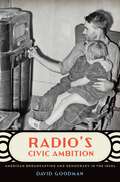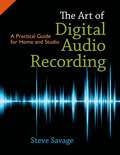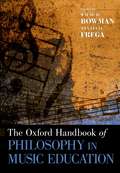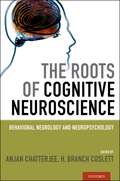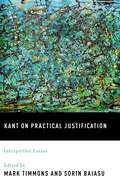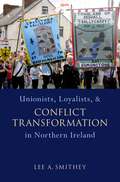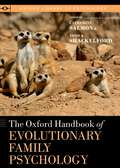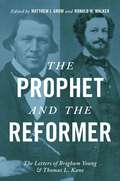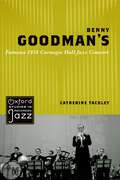- Table View
- List View
The Oxford Handbook of Medieval Latin Literature (Oxford Handbooks)
by Ralph Hexter David TownsendThe twenty-eight essays in this handbook represent the best current thinking in the study of Latin language and literature in the Middle Ages. Contributing authors--both senior scholars and gifted younger thinkers among them--not only illuminate the field as traditionally defined but also offer fresh insights into broader questions of literary history, cultural interaction, world literature, and language in history and society. Their studies vividly illustrate the field's complexities on a wide range of topics, including canonicity, literary styles and genres, and the materiality of manuscript culture. At the same time, they suggest future possibilities for the necessarily provisional and open-ended work essential to the pursuit of medieval Latin studies. The overall approach of The Oxford Handbook of Medieval Latin Literature makes this volume an essential resource for students of the ancient world interested in the prolonged after-life of the classical period's cultural complexes, for medieval historians, for scholars of other medieval literary traditions, and for all those interested in delving more deeply into the fascinating more-than-millennium-long passage between the ancient Mediterranean world and what we consider modernity.
Spinoza's Metaphysics: Substance and Thought
by Yitzhak Y. MelamedYitzhak Melamed here offers a new and systematic interpretation of the core of Spinoza's metaphysics. In the first part of the book, he proposes a new reading of the metaphysics of substance in Spinoza: he argues that for Spinoza modes both inhere in and are predicated of God. Using extensive textual evidence, he shows that Spinoza considered modes to be God's propria. He goes on to clarify Spinoza's understanding of infinity, mereological relations, infinite modes, and the flow of finite things from God's essence. In the second part of the book, Melamed relies on this interpretation of the substance-mode relation and the nature of infinite modes and puts forward two interrelated theses about the structure of the attribute of Thought and its overarching role in Spinoza's metaphysics. First, he shows that Spinoza had not one, but two independent doctrines of parallelism. Then, in his final main thesis, Melamed argues that, for Spinoza, ideas have a multifaceted (in fact, infinitely faceted) structure that allows one and the same idea to represent the infinitely many modes which are parallel to it in the infinitely many attributes. Thought turns out to be coextensive with the whole of nature. Spinoza cannot embrace an idealist reduction of Extension to Thought because of his commitment to the conceptual separation of the attributes. Yet, within Spinoza's metaphysics, Thought clearly has primacy over the other attributes insofar as it is the only attribute which is as elaborate, as complex, and, in some senses, as powerful as God.
Marketing Death: Culture and the Making of a Life Insurance Market in China
by Cheris Shun-ching ChanMarketing Death is the first book to offer an analysis of the emergence of a life insurance market outside of a Western context. Drawing on rich ethnographic data, it documents the processes and politics through which local cultures shape the way a market is formed and thereby sheds light on the dynamics through which modern capitalist enterprises diffuse insurance to regions with different cultural traditions.
Radio's Civic Ambition: American Broadcasting and Democracy in the 1930s
by David GoodmanIn its golden age, American radio both entertained and also fostered programs meant to produce self-governing and opinion-forming individuals, promoting openness to change and tolerance of diversity, familiarity with classical music, and knowledge of world affairs. As author David Goodman argues, the ambitions of radio's golden age have strong significance today as evidence that media regulation in the public interest can have significant and often positive effects.
The Art of Digital Audio Recording: A Practical Guide for Home and Studio
by Steve SavageMaking great audio recordings requires striking the right balance between technical know-how and practical understanding of recording sessions. Even in the digital age, some of the most important aspects of creating and recording music are non-technical and, as a result, are often overlooked by traditional recording manuals. The Art of Digital Audio Recording teaches readers what they really need to know in order to make great sound recordings with computers - both the practical and the technical information, including: · What to look and listen for in a recording environment · Straightforward advice on recording almost any instrument · Essentials of digital audio workstations · Essentials of recording gear: microphones, mixers, and speakers · Fundamentals of understanding and applying EQ, compression, delay, and reverb · Secrets to running creative recording sessions · Practical application of digital editing, mixing, and mastering A special section identifies solutions to the most common challenges in the recording studio, and the book also features an addendum with essential tips and reference information including: · How to walk into a commercial studio and be the engineer · Researching and buying gear: Internet vs. brick and mortar · Digital formats: A handy reference As a whole, The Art of Digital Audio Recording is an essential resource that gives recordists the tools they need to let technical understanding serve greater musical goals.
Dharma: Its Early History in Law, Religion, and Narrative (South Asia Research)
by Alf HiltebeitelBetween 300 BCE and 200 CE, concepts and practices of dharma attained literary prominence throughout India. Both Buddhist and Brahmanical authors sought to clarify and classify their central concerns, and dharma proved a means of thinking through and articulating those concerns. Alf Hiltebeitel shows the different ways in which dharma was interpreted during that formative period: from the grand cosmic chronometries of kalpas and yugas to narratives about divine plans, gendered nuances of genealogical time, royal biography (even autobiography, in the case of the emperor Asoka), and guidelines for daily life, including meditation. He reveals the vital role dharma has played across political, religious, legal, literary, ethical, and philosophical domains and discourses about what holds life together. Through dharma, these traditions have articulated their distinct visions of the good and well-rewarded life. This insightful study explores the diverse and changing significance of dharma in classical India in nine major dharma texts, as well some shorter ones. Dharma proves to be a term by which to make a fresh cut through these texts, and to reconsider their own chronology, their import, and their relation to each other.
Chest Imaging Cases (Cases in Radiology)
by Sanjeev Bhalla Cylen Javidan-Nejad Kristopher W. Cummings Andrew J. BierhalsChest Imaging Cases thoroughly encompasses the field of thoracic radiology through 137 cases covering common and challenging radiologic and clinical issues. The cases are divided into categories important for board examinations and clinical practice: diagnoses that should be made on radiography, trachea, esophagus, chest wall, thoracic outlet, congenital lesions, mediastinal lesions, pleura, diaphragm, pulmonary masses, diffuse lung disease, pulmonary vascular disease, thoracic trauma, and post-surgical complications. Using a problem and solution format, each case features high-quality images, practical differential diagnoses, approaches to daily practice, management pearls and suggested readings. Concise discussions keep cases brief and informative, allowing for efficient learning and interpretation. Chest Imaging Cases is the essential resource for honing diagnostic skills in thoracic radiology for students, physicians-in-training and practitioners.
The Oxford Handbook of Philosophy in Music Education (Oxford Handbooks)
Music education thrives on philosophical inquiry, the systematic and critical examination of beliefs and assumptions. Yet philosophy, often considered abstract and irrelevant, is often absent from the daily life of music instructors. In The Oxford Handbook of Philosophy in Music Education, editors Wayne D. Bowman and Ana Lucía Frega have drawn together a variety of philosophical perspectives from the profession's most exciting scholars. Rather than relegating philosophical inquiry to moot questions and abstract situations, the contributors to this volume address everyday concerns faced by music educators everywhere, demonstrating that philosophy offers a way of navigating the daily professional life of music education and proving that critical inquiry improves, enriches, and transforms instructional practice for the better. Questioning every musical practice, instructional aim, assumption, and conviction in music education, The Oxford Handbook of Philosophy in Music Education presents new and provocative approaches to the practice of teaching music. Bowman and Frega go deeper than mere advocacy or a single point of view, but rather conceive of philosophy as a dynamic process of debate and reflection that must constantly evolve to meet the shifting landscapes of music education. In place of the definitive answers often associated with philosophical work, Bowman and Frega offer a fascinating cross-section of often-contradictory approaches and viewpoints. By bringing together essays by both established and up-and-coming scholars from six continents, Bowman and Frega go beyond the Western monopoly of philosophical practice and acknowledge the diversity of cultures, instructors, and students who take part in music education. This range of perspectives invites broader participation in music instruction, and presents alternative answers to many of the fields most pressing questions and issues. By acknowledging the inherent plurality of music educational practices, the Handbook opens up the field in new and important ways. Emphasizing clarify, fairness, rigor, and utility above all, The Oxford Handbook of Philosophy in Music Education challenges music educators around the world to make their own decisions and ultimately contribute to the conversation themselves.
Anti-Monopoly Law and Practice in China
by H. Stephen Harris Peter J. Wang Mark A. Cohen Yizhe Zhang Sebastien J EvrardThe China Anti-Monopoly Law (AML), which became effective August 1, 2008, is the first comprehensive competition law enacted by China. The AML prohibits a broad array of agreements between competitors and commercial counterparties, as well as competitive conduct by single firms that may harm the competitive process. In addition, it establishes a mandatory administrative review procedure for mergers and acquisitions between companies meeting certain sales thresholds, globally or in China. Beyond these fundamental provisions, the AML prohibits certain types of administrative abuses believed to be prevalent in China and establishes a complex set of administrative agencies with broad powers to enforce the law. Anti-Monopoly Law and Practice in China is the first comprehensive treatment of the AML and the practice of antitrust law under this new system. Each chapter on the substantive provisions of the law includes practical advice on approaches to meeting the challenge of complying with the law's requirements, including analysis of likely interpretations and applications of the AML based on precedents in related economic laws and actions by other administrative agencies. Where policy choices are uncertain, the text will explore probable developments in China based on comparable applications of competition laws in other jurisdictions.
Indispensable Counsel: The Chief Legal Officer in the New Reality
by E. Norman Veasey Christine T. Di GuglielmoLegislation and case law following the relatively recent corporate scandals have increased scrutiny on the ethics and integrity of individuals, and the culture they create, at the highest levels within the corporate structure. The corporate General Counsel (GC) is a key member of that group. This enhanced attention increases the already substantial tensions facing the GC, who must navigate the demands and interests of various corporate stakeholders-including the board of directors, officers (particularly the CEO), stockholders, and employees-while also serving the best interests of the client, which is-and should only be-the corporation itself. In light of these heightened expectations on ethics, integrity, and other liability concerns, Indispensable Counsel: The Chief Legal Officer in the New Reality examines the key role of the independent, yet business-oriented, chief legal officer. Indispensable Counsel provides readers with the foundations of corporate representation followed by practical guidelines on how the multiple roles of GC are, or should be, resolved, with best practices as the goal. Former Supreme Court Justice of Delaware E. Norman Veasey and coauthor Christine T. Di Guglielmo bring their stature and wealth of experience in the field to bear in this must-have resource for anyone interested in the role of corporate counsel.
The Last Segregated Hour: The Memphis Kneel-Ins and the Campaign for Southern Church Desegregation
by Stephen R. HaynesOn Palm Sunday 1964, at the Second Presbyterian Church in Memphis, a group of black and white students began a "kneel-in" to protest the church's policy of segregation, a protest that would continue in one form or another for more than a year and eventually force the church to open its doors to black worshippers. In The Last Segregated Hour, Stephen Haynes tells the story of this dramatic yet little studied tactic which was the strategy of choice for bringing attention to segregationist policies in Southern churches. "Kneel-ins" involved surprise visits to targeted churches, usually during Easter season, and often resulted in physical standoffs with resistant church people. The spectacle of kneeling worshippers barred from entering churches made for a powerful image that invited both local and national media attention. The Memphis kneel-ins of 1964-65 were unique in that the protesters included white students from the local Presbyterian college (Southwestern, now Rhodes). And because the protesting students presented themselves in groups that were "mixed" by race and gender, white church members saw the visitations as a hostile provocation and responded with unprecedented efforts to end them. But when Church officials pressured Southwestern president Peyton Rhodes to "call off" his students or risk financial reprisals, he responded that "Southwestern is not for sale." Drawing on a wide range of sources, including extensive interviews with the students who led the kneel-ins, Haynes tells an inspiring story that will appeal not only to scholars of religion and history, but also to pastors and church people concerned about fostering racially diverse congregations.
The Oxford Handbook of Crime and Criminal Justice (Oxford Handbooks)
Although criminal justice systems in developed Western countries are much alike in form, structure, and function, the American system is unique. While it is structurally similar to those of other Western countries, the punishments it imposes are often vastly harsher. No other Western country retains capital punishment or regularly employs life-without-parole, three-strikes, or lengthy mandatory minimum sentencing laws. As a result, the U.S. imprisonment rate of nearly 800 per 100,000 residents dwarfs rates elsewhere. The Oxford Handbook of Crime and Criminal Justice is an essential guide to the development and operation of the American criminal justice system. A leading scholar in the field and an experienced editor, Michael Tonry has brought together a team of first-rate scholars to provide an authoritative and comprehensive overview and introduction to this crucial institution. Expertly organized, the various sections of the Handbook explore the American criminal justice system from a variety of perspectives-including its purposes, functions, problems, and priorities-and present analyses of police and policing, juvenile justice, prosecution and sentencing, and community and institutional corrections, making it a complete and unrivaled portrait of how America approaches crime and criminal justice, and giving persuasive answers as to why and how it has developed to what it is today. Accessibly written for a wide audience, the Handbook serves as a definitive reference for scholars and a broad survey for students in criminology and criminal justice.
The Oxford Anthology of Roman Literature
Though the wonders of ancient Roman culture continue to attract interest across the disciplines, it is difficult to find a lively, accessible collection of the full range of the era's literature in English. The Oxford Anthology of Roman Literature provides a general introduction to the literature of the Roman empire at its zenith, between the second century BC and the second century AD. Two features of this extraordinarily fertile period in literary achievement as evidenced by this anthology are immediately and repeatedly clear: how similar the Romans' view of the world was to our own and, perhaps even more obviously, how different it was. Most of the authors included in the anthology wrote in Latin, but as the anthology moves forward in time, relevant Greek texts that reflect the cultural diversity of Roman literary life are also included, something no other such anthology has done in the past. Roman literature was wonderfully creative and diverse, and the texts in this volume were chosen from a broad range of genres: drama, epic, philosophy, satire, lyric poetry, love poetry. By its very nature an anthology can abbreviate and thus obscure the most attractive features of even a masterpiece, so the two editors have not only selected texts that capture the essence of the respective authors, but also have included accompanying introductions and afterwords that will guide the reader in pursuing further reading. The presentations of the selections are enlivened with illustrations that locate the works within the contexts of the world in which they were written and enjoyed. The student and general reader will come away from this learned yet entertaining anthology with a fuller appreciation of the place occupied by literature in the Roman world.
The Roots of Cognitive Neuroscience: Behavioral Neurology and Neuropsychology
by Anjan Chatterjee H. Branch CoslettThe Roots of Cognitive Neuroscience takes a close look at what we can learn about our minds from how brain damage impairs our cognitive and emotional systems. This approach has a long and rich tradition dating back to the 19th century. With the rise of new technologies, such as functional neuroimaging and non-invasive brain stimulation, interest in mind-brain connections among scientists and the lay public has grown exponentially. Behavioral neurology and neuropsychology offer critical insights into the neuronal implementation of large-scale cognitive and affective systems. The book starts out by making a strong case for the role of single case studies as a way to generate new hypotheses and advance the field. This chapter is followed by a review of work done before the First World War demonstrating that the theoretical issues that investigators faced then remain fundamentally relevant to contemporary cognitive neuroscientists. The rest of the book covers central topics in cognitive neuroscience including the nature of memory, language, perception, attention, motor control, body representations, the self, emotions, and pharmacology. There are chapters on modeling and neuronal plasticity as well as on visual art and creativity. Each of these chapters take pains to clarify how this research strategy informs our understanding of these large scale systems by scrutinizing the systematic nature of their breakdown. Taken together, the chapters show that the roots of cognitive neuroscience, behavioral neurology and neuropsychology, continue to ground our understanding of the biology of mind and are as important today as they were 150 years ago.
Kant on Practical Justification: Interpretive Essays
by Mark Timmons Sorin BaiasuThis volume of new essays provides a comprehensive and structured examination of Kant's justification of norms, a crucial but neglected theme in Kantian practical philosophy. The essays engage with the view that a successful account of justification of normative claims has to be non-metaphysical and go on to pursue further implications in ethics, legal and political philosophy, and philosophy of religion.
Unionists, Loyalists, and Conflict Transformation in Northern Ireland (Studies in Strategic Peacebuilding)
by Lee A. SmitheyIn Northern Ireland, a once seemingly intractable conflict is in a state of transformation. Lee A. Smithey offers a grassroots view of that transformation, drawing on interviews, documentary evidence, and extensive field research. He offers essential models for how ethnic and communal-based conflicts can shift from violent confrontation toward peaceful co-existence. Smithey focuses particularly on Protestant unionists and loyalists in Northern Ireland, who maintain varying degrees of commitment to the Protestant faith, the Crown, and and Ulster / British identity. He argues that antagonistic collective identities in ethnopolitical conflict can become less polarizing as partisans adopt new conflict strategies and means of expressing identity. Consequently, the close relationship between collective identity and collective action is a crucial element of conflict transformation. Smithey closely examines attempts in Protestant/unionist/loyalist communities and organizations to develop more constructive means of expressing collective identity and pursuing political agendas that can help improve community relations. Key leaders and activists have begun to reframe shared narratives and identities, making possible community support for negotiations, demilitarization, and political cooperation, while also diminishing out-group polarization. As Smithey shows, this kind of shift in strategy and collective vision is the heart of conflict transformation, and the challenges and opportunities faced by grassroots unionists and loyalists in Northern Ireland can prove instructive for other regions of intractable conflict.
In God's Empire: French Missionaries and the Modern World
by Owen White J. P. DaughtonA collection of original essays by leading scholars in the field, In God's Empire examines the complex ways in which the spread of Christianity by French men and women shaped local communities, French national prowess, and global politics in the two centuries following the French Revolution. More than a story of religious proselytism, missionary activity was an essential feature of French contact and interaction with local populations. In many parts of the world, missionaries were the first French men and women to work and live among indigenous societies. For all the celebration of France's secular "civilizing mission," it was more often than not religious workers who actually fulfilled the daily tasks of running schools, hospitals, and orphanages. While their work was often tied to small villages, missionaries' interactions had geopolitical implications. Focusing on many regions - from the Ottoman Empire and North America to Indochina and the Pacific Ocean - this book explores how France used missionaries' long connections with local communities as a means of political influence and justification for colonial expansion. In God's Empire offers readers both an overview of the major historical dimensions of the French evangelical enterprise, as well as an introduction to the theoretical and methodological challenges of placing French missionary work within the context of European, imperial, religious history, and world history.
Storytelling for Lawyers
by Philip MeyerGood lawyers have an ability to tell stories. Whether they are arguing a murder case or a complex financial securities case, they can capably explain a chain of events to judges and juries so that they understand them. The best lawyers are also able to construct narratives that have an emotional impact on their intended audiences. But what is a narrative, and how can lawyers go about constructing one? How does one transform a cold presentation of facts into a seamless story that clearly and compellingly takes readers not only from point A to point B, but to points C, D, E, F, and G as well? In Storytelling for Lawyers, Phil Meyer explains how. He begins with a pragmatic theory of the narrative foundations of litigation practice and then applies it to a range of practical illustrative examples: briefs, judicial opinions and oral arguments. Intended for legal practitioners, teachers, law students, and even interdisciplinary academics, the book offers a basic yet comprehensive explanation of the central role of narrative in litigation. The book also offers a narrative tool kit that supplements the analytical skills traditionally emphasized in law school as well as practical tips for practicing attorneys that will help them craft their own legal stories.
The Oxford Handbook of Evolutionary Family Psychology (Oxford Library of Psychology)
Relationships with family are important to our emotional health and can play a significant role in our social success. We need our families and yet frequently have a great difficulty understanding them. Hundreds of books have been published with the goal of improving understanding and relationships among family and relationships; few, if any, have done so with an evolutionary approach. The Oxford Handbook of Evolutionary Family Psychology focuses on the reasons underlying family behavior and how a greater understanding of these factors can help us to better understand our own family behaviors. Recognizing that a deeper understanding of human families can be found through an understanding of similar phenomena in other species, the volume demonstrates how an understanding of family ties can inform understanding of our relationships to non-kin.
The Prophet and the Reformer: The Letters of Brigham Young and Thomas L. Kane
Until his death in 1877, Brigham Young guided the religious, economic, and political life of the Mormon community, whose settlements spread throughout the West and provoked a profound political, legal, and even military confrontation with the American nation. Young first met Thomas L. Kane on the plains of western Iowa in 1846. Young came to rely on Kane, 21 years his junior, as his most trusted outside adviser, making Kane the most important non-Mormon in the history of the Church. In return, no one influenced the direction of Kane's life more than Young. The letters exchanged by the two offer crucial insights into Young's personal life and views as well as his actions as a political and religious leader. The Prophet and the Reformer offers a complete reproduction of the surviving letters between the Mormon prophet and the Philadelphia reformer. The correspondence reveals the strategies of the Latter-day Saints in relating to American culture and government during these crucial years when the "Mormon Question" was a major political, cultural, and legal issue. The letters also shed important light on the largely forgotten "Utah War" of 1857-58, triggered when President James Buchanan dispatched a military expedition to ensure federal supremacy in Utah and replace Young with a non-Mormon governor. This annotated collection of their correspondence reveals a great deal about these two remarkable men, while also providing crucial insight into nineteenth-century Mormonism and the historical moment in which the movement developed.
Functional Morphology and Diversity (The Natural History of the Crustacea)
by Les Watling Martin ThielCrustaceans are increasingly used as model organisms in all fields of biology, including neurobiology, developmental biology, animal physiology, evolutionary ecology, biogeography, and resource management. One reason for the increasing use of crustacean examples is the wide range of phenotypes found in this group and the diversity of environments they inhabit; few other taxa exhibit such a variety of body shapes and adaptations to particular habitats and environmental conditions. A good overview of their functional morphology is essential to understanding many aspects of their biology. This volume is the first in The Natural History of Crustacea series, a ten-volume series that will treat all aspects of crustacean biology, physiology, behavior, and evolution. The series updates and synthesizes a growing wealth of information on the natural history of this remarkable group. Functional Morphology and Diversity explores the functional morphology of crustaceans, which cover the main body parts and systems. The book brings together a group of internationally recognized-and up-and-coming-experts in fields related to systematics and morphology. Contributing authors study a range of crustacean taxa and topics, and thus the volume provides a compact overview of the great phenotypic diversity and their function found among crustaceans. The first broad treatment of Crustacea in decades, the book will be invaluable for researchers and students in this and related fields.
Neuroscientific Foundations of Anesthesiology
by George A. Mashour Ralph LydicAlthough the perioperative care of patients by anesthesiologists draws on diverse clinical skills, the principles of anesthesiology and pain management are rooted in the neurosciences. The Neuroscientific Foundations of Anesthesiology thoroughly examines the anesthetic modulation of the central, peripheral, and autonomic nervous systems and will help redefine anesthesiology as a fundamentally neuroscientific field. The book is organized by sections, with each focusing on a different part of the nervous system. State-of-the-art chapters written by thought-leaders in anesthesiology and neuroscience provide a novel and invaluable resource.
Benny Goodman's Famous 1938 Carnegie Hall Jazz Concert (Oxford Studies in Recorded Jazz)
by Catherine TackleyOn January 16, 1938 Benny Goodman brought his swing orchestra to America's venerated home of European classical music, Carnegie Hall. The resulting concert - widely considered one of the most significant events in American music history - helped to usher jazz and swing music into the American cultural mainstream. This reputation has been perpetuated by Columbia Records' 1950 release of the concert on LP. Now, in Benny Goodman's Famous 1938 Carnegie Hall Jazz Concert, jazz scholar and musician Catherine Tackley provides the first in depth, scholarly study of this seminal concert and recording. Combining rigorous documentary and archival research with close analysis of the recording, Tackley strips back the accumulated layers of interpretation and meaning to assess the performance in its original context, and explore what the material has come to represent in its recorded form. Taking a complete view of the concert, she examines the rich cultural setting in which it took place, and analyzes the compositions, arrangements and performances themselves, before discussing the immediate reception, and lasting legacy and impact of this storied event and album. As the definitive study of one of the most important recordings of the twentieth-century, Benny Goodman's Famous 1938 Carnegie Hall Jazz Concert is a must-read for all serious jazz fans, musicians and scholars.
Poverty, Battered Women, and Work in U.S. Public Policy (Interpersonal Violence)
by Lisa D. BrushDrawing on longitudinal interviews, government records, and personal narratives, feminist sociologist Lisa Brush examines the intersection of work, welfare, and battering. Brush contrasts conventional wisdom with illuminating analyses of social change and social structures, highlighting how race and class shape women's experiences with poverty and abuse and how "domestic" violence moves out of the home and follows women to work. Brush's unique interview data on work-related control, abuse, and sabotage, together with administrative data on earnings, welfare, and restraining orders, offer new empirical insights on the impact of work requirements and other post-welfare rescission changes on the lives of low-income and battered mothers. Personal narratives provide first-hand accounts of women's perceptions of the broad forces that shape the circumstances of their everyday lives, their health, their prospects, their ambitions, and their diagnoses of their world. Deftly integrating the political and the personal, the administrative and the narrative, the economic and the emotional, Brush underscores the vital need to reexamine ideas, policies, and practices meant to keep women safe and economically productive that instead trap women in poverty and abuse. With her fresh approach to problems people often see as intractable, Brush offers a new way of calculating the costs of battering for the policy makers and practitioners concerned with the well being of poor, battered women and their families and communities.
The Oxford Handbook of Civil Society (Oxford Handbooks)
In the past two decades, '"civil society" has become a central organizing concept in the social sciences. Occupying the middle ground between the state and private life, the civil sphere encompasses everything from associations to protests to church groups to nongovernmental organizations. Interest in the topic exploded with the decline of statism in the 1980s and 1990s, and many of our current debates about politics and social policy are informed by the renewed focus on civil society. Michael Edwards, author of the most authoritative single-authored book on civil society, serves as the editor for The Oxford Handbook of Civil Society. Broadly speaking, the book views the topic through three prisms: as a part of society (voluntary associations), as a kind of society (marked out by certain social norms), and as a space for citizen action and engagement (the public square or sphere). It does not focus solely on the West (a failing of much of the literature to date), but looks at civil society in both the developed and developing worlds. Throughout, it merges theory, practice, and empirical research. In sum, The Oxford Handbook on Civil Society will be the definitive work on the topic.



